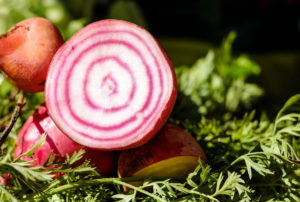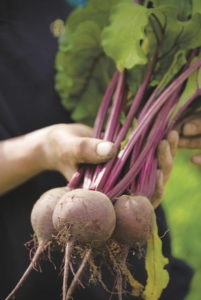Written by Shawna Coronado
Beets are a favorite cool-season crop among home gardeners. In the North, beets can be grown in the cooler weather of the spring and fall; they are not particularly fond of heat as the root will harden. In the South, much of winter is beet growing season; soil temps need to reach at least 40F for the seeds to sprout.
Beets 101
 Also known as beetroot or blood turnip, a beet is an herbaceous biennial vegetable root although it can sometimes be perennial dependent upon its survival over winter. Beets have swollen and fleshy roots that are typically deep maroon red, but also come in white, yellow, and even striped varieties.
Also known as beetroot or blood turnip, a beet is an herbaceous biennial vegetable root although it can sometimes be perennial dependent upon its survival over winter. Beets have swollen and fleshy roots that are typically deep maroon red, but also come in white, yellow, and even striped varieties.
Grow beets for their tasty root but also for their stem, which is edible and in the chard family. Its leaves are often heart-shaped and the colorful ribs can be quite beautiful. Did you know beets have the highest sugar content of any vegetable?
How to Grow Beets
You’ll start beets from seed – but each “seed” in your packet is actually a cluster of two to five individual seeds. Presoak your seeds and plant 9 or 16 per square depending on the variety’s size. For a continuous harvest, plant a new square every three weeks but remember to take a break in the hottest part of the summer. Germination should be in approximately 14 days but can be sooner. Once the sprouts are about an inch tall, keep the strongest plant and cut off the other sprouts in the cluster.
Harvesting Your Beet Beauties
 When you see the root sticking above the ground a bit you’re ready to start harvesting. Beets are the most tender when they’re the size of a ping pong ball; don’t let the roots get larger than a tennis ball as beets often get tough if you wait too long to harvest. Full ripeness is somewhere between 49 to 70 days after planting, dependent upon variety.
When you see the root sticking above the ground a bit you’re ready to start harvesting. Beets are the most tender when they’re the size of a ping pong ball; don’t let the roots get larger than a tennis ball as beets often get tough if you wait too long to harvest. Full ripeness is somewhere between 49 to 70 days after planting, dependent upon variety.
Remove tops by twisting off or cutting them. Be sure to leave about three inches of stem attached to the beet so it will not “bleed” and drip juices. This also keeps the roots fresher for a longer period of time.
Packed with Vitamins and Flavor – The Versatile Beet
While beets are absolutely delicious eaten raw, boiled, baked, pickled or fermented, their greens are also exceptionally tasty on their own. Cooked or fresh in a salad, beet greens come with an added benefit of fiber and loads of vitamins.
Every 100 grams of beets have around 27% of the recommended daily allowance of Folate (or B9). They are also rich in protein, phosphorus, calcium, and magnesium. Consider growing beets as a part of your eat-more-vegetables health plan for the whole family.



